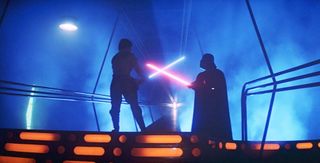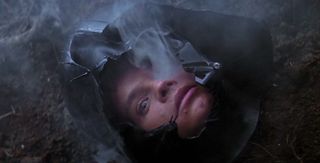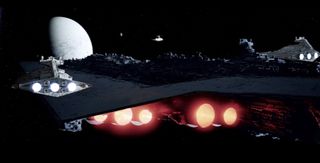The effect of 'Star Wars: The Empire Strikes Back' can still be felt after 40 years

Following the cinematic impact of "Star Wars" in 1977, every movie studio everywhere was scrambling for space-based screenplays; suddenly sci-fi was back in vogue, for a few years at least. And as a result, the 80s began with a flurry of new movies, some good and some very, very bad. But among the hits were the enjoyable "Battle Beyond the Stars," the epic "Flash Gordon" and the eerie "Saturn 3."
The year 1980 was also a vintage year for sequels, with "Superman II," "Mad Max II" and of course, "Star Wars: The Empire Strikes Back." It's hard to believe that arguably the best "Star Wars" movie made so far was released 40 years ago and the effect it has on pop culture can still be measured.
The world was a very different place back in 1980; we laughed at the medical misbehavior in "M*A*S*H," drove ourselves crazy with the Rubik's Cube and played Pac-Man in arcades. But there was no internet, and fans of sci-fi movies and TV shows had to rely on hearing news mainly through dedicated comics and magazines like Starlog in the U.S. and Starburst, 2000 AD and even Look-In, if you were in the U.K.
The point is, no one really thought much about a sequel to "Star Wars." After all, if you hadn't reached the fifth grade yet, you would have been forgiven for believing that the Empire had been defeated, especially with the way the Rebel Alliance was just handing out medals in elaborate ceremonies.
Related: The greatest 'Star Wars' movie plot twists of all time
That said, if you were following the further adventures of Luke, Leia, Han, Chewie et al. in Marvel's Star Wars Weekly comic — combined with an active imagination and maybe even a few of the early Kenner toys — it was easy to assume that the struggle against the Empire was going to continue for some time to come.
However, unless you were reading trade press titles, like The Hollywood Reporter or Variety, you probably wouldn't have heard that principal photography of "Empire" started early in 1979. Even fewer folk probably knew that George Lucas had imagined a six-movie saga while he was writing the script, which eventually grew to a nine-movie saga. Lucas always had more of a story to tell, but he wasn't sure if "Star Wars" would be successful. It was soon apparent that the box office numbers and licensing opportunities meant that a sequel was inevitable.
Get the Space.com Newsletter
Breaking space news, the latest updates on rocket launches, skywatching events and more!
For a few years, following the runaway success of "Star Wars," there were numerous attempts to jump on the bandwagon. Middle Eastern-style settings, warriors and princesses, laser swords and fairytale happy endings were easy plot elements to reproduce for low-budget B-movies. Just look at "Starcrash."

All sorts of new ideas were considered for the second movie, and a first draft was written by Leigh Brackett. Sadly, however, she died of cancer shortly after submitting it to Lucas, and they never had a chance to develop it together. Lucas wrote the next draft himself but was unhappy with the result. Consequently, he began to consider new directions in which to take the story, including the plot twist of Darth Vader being Luke's father.
At about the same time that the script for "Empire" was being developed, another sci-fi movie was making waves, but this one was not for all the family. In 1979, Ridley Scott's "Alien" was unleashed and it successfully showed that sci-fi could go in many different directions, including somewhere dark.
"Empire" is considered the darkest of all the "Star Wars" movies and of that, there is no doubt, but this isn't the only reason it had such an effect on sci-fi and pop-culture. Despite the flowery finale in "Star Wars," it actually had a number of pretty damn dark moments of its own: Darth Vader crushes the neck of a Rebel Alliance officer on the Tantive IV, Owen and Beru Lars are murdered and Ponda Baba loses an arm in the Mos Eisley cantina, to name just a few.

"I wasn't really aware of the dark nature the first time I saw 'Empire.' I was so young that the cinema was a kind of spooky, dark experience for me anyway," Jamie Benning, producer of the documentaries "Star Wars Begins" and "Building Empire" told Space.com.
"But later in my early teens I did become aware at what a gamble the sequel had been. I mean, 'Star Wars' couldn't be more jolly, it would tip over into parody [sic]. But 'Empire' had a weight and a heft that grew with me as I grew."
The darkness of "Empire" was much deeper than a few frames of a dismembered alien arm, or the charred corpses of Luke's adoptive mother and father. We learnt much more about the dark side of the Force and its seductive attraction. We learned about how tempting it could be to the young and inexperienced and we learnt about how it thrived on fear, anger and suffering.

And of course, it deals with betrayal and the potential loss of someone that we deeply care for. "Empire" showed that not everything in life always ends well or the way we would hope.
Freezing Han in carbonite was, at least in part, a result of the uncertainty that Harrison Ford would return for a third movie. Back in 1977, Carrie Fisher and Mark Hamill had signed for a three-movie deal, but Ford had refused. He even requested that Lucas kill off Solo, but as we all know, he refused saying Solo still had a heroic part to play in the concluding movie, what would eventually be "Return of the Jedi."
That famous scene in Cloud City, where Solo is frozen and encased in carbonite, is incredibly emotional — not just for Leia, but also for Chewbacca, who knows he could be watching his very best friend die. Quite why he doesn't pull Lando's arms out of their sockets later is still a mystery.

But the film's non-traditional take on storytelling doesn't end there.
"I don't even really consider the 'Star Wars' films sci-fi," says Benning. "It's been said many times before, but they are more like fairy tales. As to the effect it had on sequels, I think it was one of the first times that a sequel was not a poor imitation of the original. If anything, it arguably bettered the original in just about every regard. The story, the character development, the visual style, everything."
And not every fairy tale is quite as fluffy as we first thought when we look at them again as adults.
Much of this was a direct result of the input of a young writer by the name of Lawrence Kasdan. He had just completed writing "Raiders of the Lost Ark" and with a recommendation from Steven Spielberg, Lucas hired him to write the next drafts, together with input from director Irvin Kershner. Kasdan, Kershner and producer Gary Kurtz saw the "Star Wars" sequel as a more serious and mature movie and developed it this way in contrast to the original's lighter tone. Episode 452 of the excellent Script Notes podcast talks to Lawrence Kasdan about this.
"Empire" also had a monumental plot twist that was equal in shock value only to the end scene of "Planet of the Apes." The security surrounding the movie was so tight that Lucas received regular reports about leaks from any of the actors. He was determined that the ending be kept secret, so he had David Prowse (Darth Vader) say "Obi-wan killed your father" and James Earl Jones later dubbed it with "I am your father."

In fact, only five people knew about the ending before the movie's release: Lucas (came up with the idea in his second draft, after the death of Brackett), Kershner (informed during story conferences), Kasdan (also informed during story and script conferences), Hamill (informed shortly before the shooting of the infamous scene) and Jones (informed during the recording sessions for the final dub and who genuinely believed that Vader was lying).
This really was the equivalent of an "Avengers" movie today, and "Empire" preceded it by four decades. And just like the existence of darker sci-fi like "Alien" around the same time was probably a small influence on the writers – even if it was just giving them confidence to go in that direction – "The Empire Strikes Back" more than likely had an influence on another great sci-fi sequel, "Star Trek: The Wrath of Khan," specifically, the confidence to "kill off" a major character.
"Empire" was groundbreaking, of that there is no doubt. It was bold, brave and it broke away from convention. It was also beautiful, introducing us to new alien worlds, new characters, new creatures and new machines, all within the still fledgling "Star Wars" universe. We saw the true might of the Empire well beyond the Death Star and it included enormous Executor-class Star Destroyers and All Terrain Armored Transports. The premise was kept simple and yet it surprised us at every turn. The last thing anyone expected was an adorable, two-foot high, elderly green goblin when we heard Luke was going to visit the Jedi master who taught Obi Wan.
- The greatest 'Star Wars' villains of all time
- 'Star Wars'! 40 surprising facts from a galaxy far, far away
- The best Disney Plus movies and shows for space fans: Star Wars, sci-fi and more
Follow Scott Snowden on Twitter. Follow us on Twitter @Spacedotcom and on Facebook.
<a href="https://www.space.com/your-favorite-magazines-space-science-deal-discount.html" data-link-merchant="space.com"" target="_blank">OFFER: Save 45% on 'All About Space' 'How it Works' and 'All About History'!
For a limited time, you can take out a digital subscription to any of <a href="https://www.space.com/your-favorite-magazines-space-science-deal-discount.html" data-link-merchant="space.com"" data-link-merchant="space.com"" target="_blank">our best-selling science magazines for just $2.38 per month, or 45% off the standard price for the first three months.
Join our Space Forums to keep talking space on the latest missions, night sky and more! And if you have a news tip, correction or comment, let us know at: community@space.com.
When Scott's application to the NASA astronaut training program was turned down, he was naturally upset...as any 6-year-old boy would be. He chose instead to write as much as he possibly could about science, technology and space exploration. He graduated from The University of Coventry and received his training on Fleet Street in London. He still hopes to be the first journalist in space.
-
Wolfshadw Oh... and if you're the one person on the planet yet to see these films, SPOILER ALERTS!Reply
-Wolf sends


